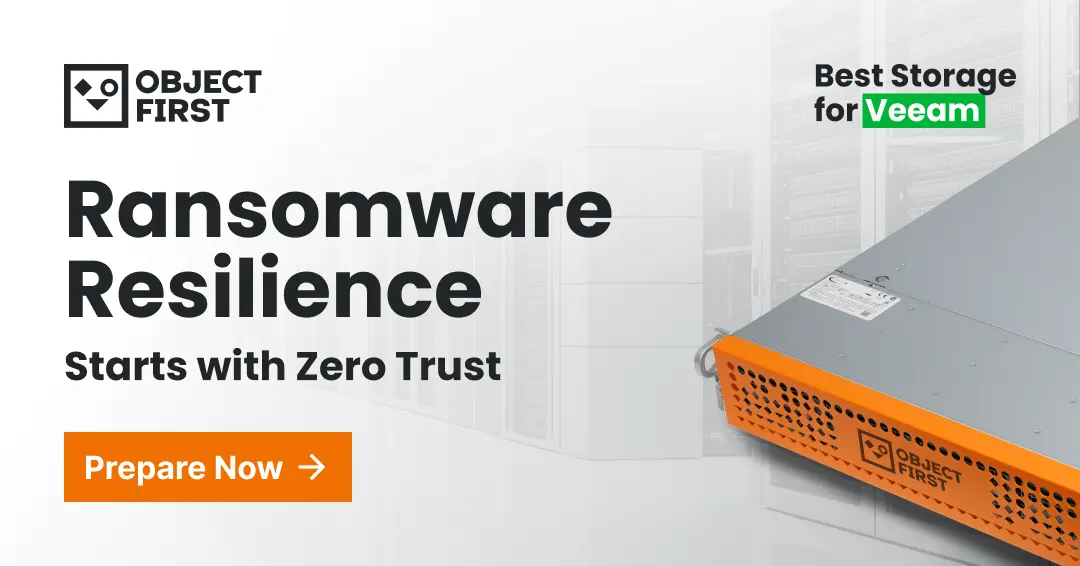Ransomware Resilience: Stay One Step Ahead of Cyber Threats
Ransomware resilience is an essential goal for businesses looking to protect their data from ransomware. By creating a clear ransomware resilience strategy, businesses can make sure they’re able to withstand ransomware—and recover from an attack, too.
New approaches such as isolated recovery environments (IRE) and immutable data vaults (IDV) can help organizations take resilience to the next level. Find out more on how to become ransomware resilient with the latest insights from Gartner.
Key Takeaways
- A clear, structured ransomware resilience strategy should see businesses assess vulnerabilities, identify critical assets, implement protection measures, enable early threat detection, establish response protocols, and continuously update defenses.
- Immutable backups and strict access controls are essential elements of ransomware resilience that ensure your data remains safe and recoverable, even if you’re attacked.
- Regular testing, drills, and employee training are all essential to ensuring that your ransomware resilience strategy will work when a ransomware attack occurs.
- Object First Ootbi (Out-of-the-Box Immutability) appliance offers secure, simple, and powerful on-premises backup storage that forms the very foundation of ransomware resilience.
What is Ransomware Resilience and Why It Matters
Ransomware resilience is the ability to withstand, respond to, and recover from ransomware attacks.
It’s particularly important nowadays, because ransomware attacks are on the rise—with nearly two-thirds (66%) of organizations facing at least one ransomware attack in the last two years.
The potential impacts of these attacks on businesses are devastating, with many businesses never recovering their data.
Cybersecurity vs. Cyber Resilience
Cybersecurity and cyber resilience sound similar, but they’re two different things: while the former concerns preventing cyberattacks like ransomware, the latter is about recovering and adapting after an actual cyberattack takes place.
Both concepts are essential for keeping businesses safe, but they require different approaches.
6 Steps to Building Your Ransomware Resilience
Here are the key steps you need to follow to build a strong ransomware resilience strategy:
Step 1: Assess Your Ransomware Resilience
A formal ransomware resilience assessment requires evaluating current defenses, including identifying gaps in policies, processes, and technical controls.
Common methods used include audits, simulations, ransomware resilience scorecards, and vulnerability reviews. This assessment is crucial because it will guide all subsequent steps in the resilience strategy.
Step 2: Identify and Prioritize Critical Assets
Using the results of the assessment in Step 1, organizations should use risk assessments and data classification to map business-critical data, applications, and infrastructure.
Step 3: Protect Data at Scale
Businesses should incorporate tactics like endpoint protection, network segmentation, and immutable backup storage appliances to protect their data. These ensure data is safe from cyberattacks at all stages of its life cycle, both in transit and at rest.
Step 4: Detect Threats Early
Early ransomware detection is essential to cyber resilience. Important tools at this stage include monitoring, Security Information and Event Management (SIEM), anomaly detection, and ransomware-specific indicators.
Step 5: Respond and Recover Effectively
The speed and effectiveness of your response are critical to ransomware data recovery. Recovery drills, backup testing, and staff training are all essential to ensuring your organization responds as quickly as possible.
Step 6: Continuous Improvement
Ransomware resilience is not a ‘one-and-done’ process. Businesses should use metrics and audits to update their strategy continuously based on new and evolving threats to ensure they remain resilient in the long-term.
Best Practices for Storage and Backup Resilience Against Ransomware
To achieve true ransomware resilience, organizations should look to apply the following best practices:
Ensure Immutable Backups
Immutable backup storage is a game-changer in ransomware resilience. Immutability is a way of ransomware-proofing backups by ensuring recovery points cannot be altered or deleted once created. This guarantees backup copies remain clean, uncompromised, and ready to restore.
Strengthen Backup Security with Isolation and Access Controls
Strict access controls are essential to blocking ransomware from reaching backups. By restricting access, businesses limit ransomware’s attack surface and minimise the damage that can be done.
The 3-2-1 backup rule is a good example of access controls, recommending organizations keep three copies of your data on two different media types, one of which is stored in an offsite location.
Automate Backup Testing for Ransomware Resilience
Automated backup testing ensures your data can actually be restored when it’s needed, validating recovery readiness and preventing silent data corruption. The automation element eliminates human error and makes it suitable even for businesses with limited IT resources.
Keep Backup Infrastructure Patched and Hardened
Ransomware attackers continue to develop more sophisticated attacks. Regularly patching and hardening storage systems ensures businesses quickly address vulnerabilities that could be exploited by ransomware and keep their data safe.
Achieve Advanced Ransomware Resilience with IRE & IDV
An IRE (Isolated Recovery Environment) is a secure, standalone environment that is physically or logically separate from the production network. This "air gap" prevents malware from spreading to the backup copy.
An IDV (Isolated Data Vault) prevents attackers from deleting or encrypting backup—since the data cannot be modified, it remains safe and uncompromised.
Download the report from Gartner® and learn how to enhance your ransomware resilience with isolated recovery environments (IRE) and immutable data vaults (IDV).
Ootbi: Ransomware-Resilient Backup Storage Solution
With ransomware threats continuing to increase, businesses without a clear resilience strategy based on proven approaches like the 3-2-1 backup rule and immutable backup storage risk losing their data permanently.
Object First Ootbi (Out-of-the-Box Immutability) appliance delivers secure, simple, and powerful backup storage purpose-built for Veeam that’s aboslutely immutable. With the ultimate ransomware defense, recovery is ensured for your business.
Download the white paper and learn why Ootbi is the Best Storage for Veeam.
Summary
Ransomware resilience is essential in today’s modern ransomware landscape. Without a solid strategy and the right tools, it’s unlikely your business will be able to withstand or recover from a ransomware attack.
Organizations looking to improve their ransomware resilience should evaluate their current backup strategy and employ resilient solutions; most important of these are backup storage hardening and immutable backup appliances, both of which genuinely improve resilience and the chances of recovery following a ransomware attack.


